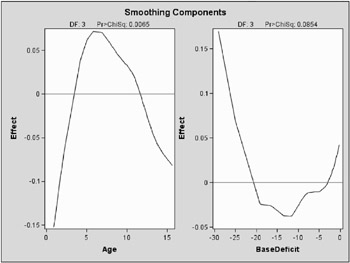Getting Started
The following example illustrates the use of the GAM procedure to explore in a nonparametric way how two factors affect a response. The data come from a study (Sockett et al. 1987) of the factors affecting patterns of insulin-dependent diabetes mellitus in children. The objective is to investigate the dependence of the level of serum C-peptide on various other factors in order to understand the patterns of residual insulin secretion. The response measurement is the logarithm of C-peptide concentration (pmol/ml) at diagnosis, and the predictor measurements are age and base deficit (a measure of acidity):
title 'Patterns of Diabetes; data diabetes; input Age BaseDeficit CPeptide @@; logCP = log(CPeptide); datalines; 5.2 8.1 4.8 8.8 16.1 4.1 10.5 0.9 5.2 10.6 7.8 5.5 10.4 29.0 5.0 1.8 19.2 3.4 12.7 18.9 3.4 15.6 10.6 4.9 5.8 2.8 5.6 1.9 25.0 3.7 2.2 3.1 3.9 4.8 7.8 4.5 7.9 13.9 4.8 5.2 4.5 4.9 0.9 11.6 3.0 11.8 2.1 4.6 7.9 2.0 4.8 11.5 9.0 5.5 10.6 11.2 4.5 8.5 0.2 5.3 11.1 6.1 4.7 12.8 1.0 6.6 11.3 3.6 5.1 1.0 8.2 3.9 14.5 0.5 5.7 11.9 2.0 5.1 8.1 1.6 5.2 13.8 11.9 3.7 15.5 0.7 4.9 9.8 1.2 4.8 11.0 14.3 4.4 12.4 0.8 5.2 11.1 16.8 5.1 5.1 5.1 4.6 4.8 9.5 3.9 4.2 17.0 5.1 6.9 3.3 5.1 13.2 0.7 6.0 9.9 3.3 4.9 12.5 13.6 4.1 13.2 1.9 4.6 8.9 10.0 4.9 10.8 13.5 5.1 ; run;
The following statements perform the desired analysis. The PROC GAM statement invokes the procedure and specifies the diabetes data set as input. The MODEL statement specifies logCP as the response variable and requests that univariate smoothing splines with the default of 4 degrees of freedom be used to model the effect of Age and BaseDeficit .
title 'Patterns of Diabetes'; proc gam data=diabetes; model logCP = spline(Age) spline(BaseDeficit); run;
The results are shown in Figure 30.1 and Figure 30.2.
| |
Patterns of Diabetes The GAM Procedure Dependent Variable: logCP Smoothing Model Component(s): spline(Age) spline(BaseDeficit) Summary of Input Data Set Number of Observations 43 Number of Missing Observations 0 Distribution Gaussian Link Function Identity Iteration Summary and Fit Statistics Final Number of Backfitting Iterations 5 Final Backfitting Criterion 5.542745E-10 The Deviance of the Final Estimate 0.4180791724
| |
Figure 30.1: Summary Statistics
| |
Patterns of Diabetes The GAM Procedure Dependent Variable: logCP Smoothing Model Component(s): spline(Age) spline(BaseDeficit) Regression Model Analysis Parameter Estimates Parameter Standard Parameter Estimate Error t Value Pr > t Intercept 1.48141 0.05120 28.93 <.0001 Linear(Age) 0.01437 0.00437 3.28 0.0024 Linear(BaseDeficit) 0.00807 0.00247 3.27 0.0025 Smoothing Model Analysis Fit Summary for Smoothing Components Num Smoothing Unique Component Parameter DF GCV Obs Spline(Age) 0.995582 3.000000 0.011675 37 Spline(BaseDeficit) 0.995299 3.000000 0.012437 39 Smoothing Model Analysis Analysis of Deviance Sum of Source DF Squares Chi-Square Pr > ChiSq Spline(Age) 3.00000 0.150761 12.2605 0.0065 Spline(BaseDeficit) 3.00000 0.081273 6.6095 0.0854
| |
Figure 30.2: Analysis of Model
In order to explore the overall shape of the relationship between each factor and the response, use the experimental graphics features of PROC GAM to plot the partial predictions .
ods html; ods graphics on; proc gam data=diabetes; model logCP = spline(Age) spline(BaseDeficit); run; ods graphics off; ods html close;
These graphical displays are requested by specifying the experimental ODS GRAPHICS statement. For general information about ODS graphics, see Chapter 15, Statistical Graphics Using ODS. For specific information about the graphics available in the GAM procedure, see the section ODS Graphics on page 1581.

Figure 30.3: Partial Predictions for each Predictor (Experimental)
Both plots show a strong quadratic pattern, with a possible indication of higher-order behavior. Further investigation is required to determine whether these patterns are real or not.